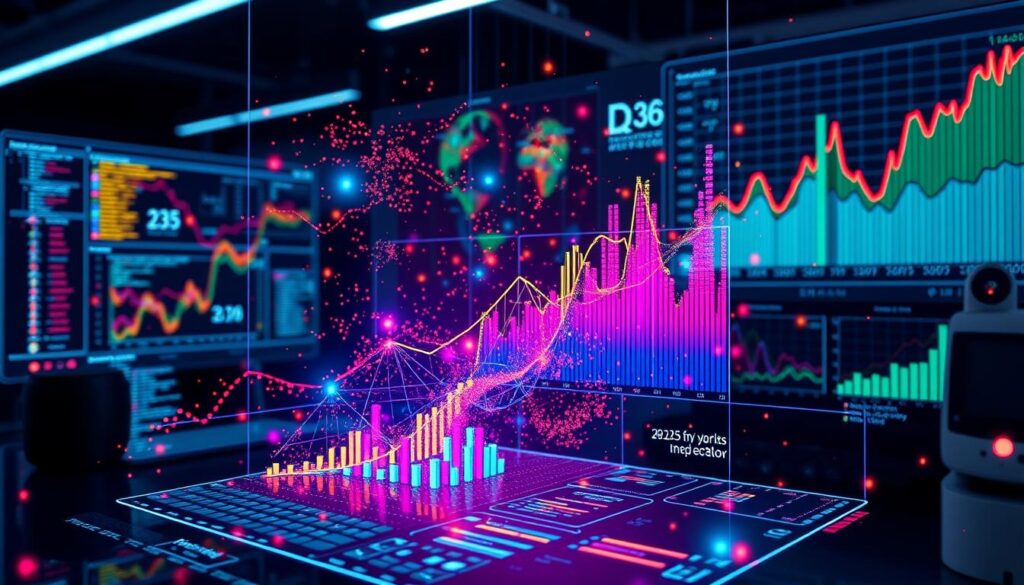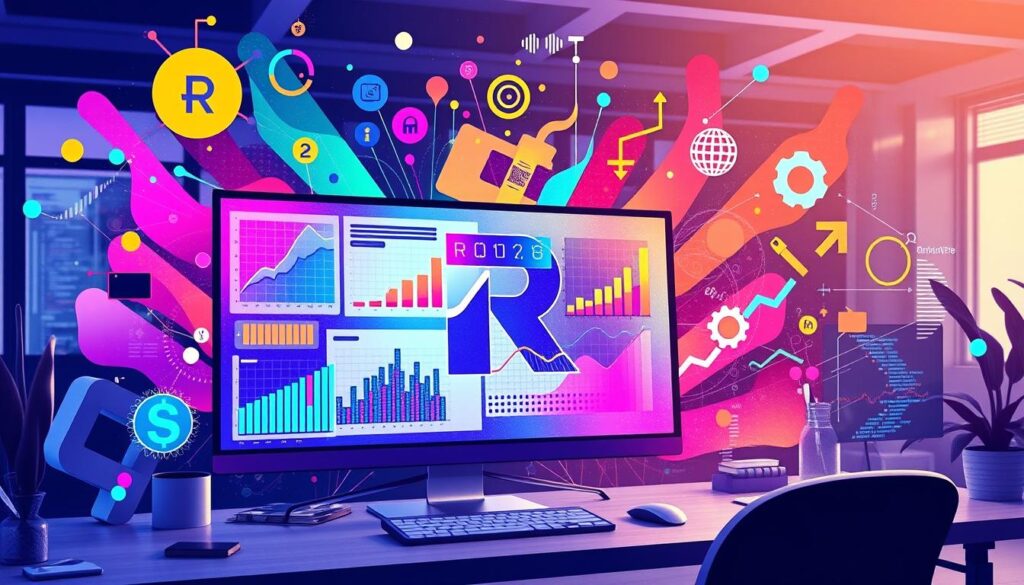As a data analyst, I’ve learned that data visualization is key to understanding complex data. R is perfect for this, offering many ways to visualize data. With R, we can make interactive and dynamic charts that guide our decisions.
Studies show that more companies are using data visualization to stay ahead. For example, checking out data visualization resources can teach you how it’s used in different areas.
Key Takeaways
- Data visualization is a powerful tool for extracting insights from complex data sets.
- R is an ideal language for data visualization, offering a wide range of Data Visualization with R techniques.
- R data visualization techniques can be used to create interactive and dynamic visualizations.
- Data visualization can help in making data-driven decisions.
- Organizations can gain a competitive edge by using data visualization to extract insights from complex data sets.
- R provides extensive visualization libraries, including ggplot2 and plotly, which offer customization options for modifying axes, fonts, legends, and labels.
- Data visualization in R can be applied in various fields, including health monitoring and meteorology.
Introduction to Data Visualization with R
R is a powerful programming language for data analysis and visualization. It’s great for businesses and individuals who want to make informed decisions. With over 15,000 packages on CRAN, R offers a lot of options for data visualization, including R plotting libraries and R ggplot2 examples.
Data visualization is key to understanding complex data sets. It helps users share their findings clearly. R is perfect for this, thanks to its many packages and libraries, like ggplot2. It makes creating beautiful, complex visualizations easy.
Importance of Data Visualization
Data visualization is essential in data analysis. It helps users spot patterns, trends, and correlations. By using R plotting libraries and R ggplot2 examples, users can make interactive, dynamic visualizations. This helps them understand their data better.
Overview of R as a Visualization Tool
R is a free programming language, making it a good choice over expensive software. Its flexibility and customizability, along with many packages and libraries, make R great for data visualization. Users can create various visualizations, from simple plots to complex interactive ones, using R plotting libraries and R ggplot2 examples.
Key R Packages for Data Visualization
As a data analyst, I’ve found R has many packages for data visualization. Each package has its own strengths and weaknesses. Choosing the right package is key to creating effective visualizations. We’ll look at ggplot2, plotly, and lattice in this section.
Choosing the right package is crucial, as tutorials often say. For example, ggplot2 is great for complex graphics. Plotly is perfect for interactive plots. Knowing what each package can do helps analysts make clear, impactful visualizations.
ggplot2: A Comprehensive Guide
ggplot2 is a top choice for R data visualization. It has many tools for creating detailed, customized graphics. Analysts can make simple plots or complex ones with ggplot2. It’s known for its flexibility and customizability.
plotly: Creating Interactive Plots
plotly is famous for interactive plots in R. It lets analysts make a variety of interactive visualizations. From simple bar charts to 3D plots, plotly makes engaging, informative visuals. It’s a must-have for any data project.
Lattice: Advanced Visualization Techniques
Lattice is a strong package for advanced visualization in R. It offers many techniques for complex, customized visualizations. Analysts can create dynamic, interactive plots with lattice. It’s great for taking visualizations to the next level.
Getting Started with ggplot2
As a data analyst, I’ve found ggplot2 to be crucial for making interactive data visualizations with R. It offers a variety of geoms and customization options. This makes it a flexible and powerful tool for showing data insights and trends.
Installing ggplot2 in R
Installing ggplot2 in R is easy. Just use the install.packages() function to download and install it. After that, load the package with the library() function.
Basic Syntax and Structure
The basic syntax of ggplot2 starts with creating a plot object using ggplot(). Then, add layers with different geoms and options. For instance, to make a simple bar plot, use this code:
Customizing Your Plots
ggplot2 is known for its flexibility and customization. It has over 40 geoms for various plot types, from bar plots to heatmaps and scatterplots. You can also change how your plots look with themes and color schemes. This makes it easy to create interactive data visualizations with R that fit your needs.
| Geom | Description |
|---|---|
| geom_bar | Creates a bar plot |
| geom_point | Creates a scatterplot |
| geom_line | Creates a line plot |
Understanding Data Types in R
Exploring Advanced data visualization in R, I see how crucial it is to grasp the various data types. Data Visualization with R is a strong tool, but knowing the basics is key. In R, data types fall into several categories, like numeric, integer, logical, and complex.
The numeric type holds decimal numbers. The integer type, made with as.integer(), is for whole numbers. Logical data returns true or false values. Complex data can handle real and imaginary numbers.
Numeric vs. Categorical Data
Numeric data in R splits into numeric and integer types. Numeric holds decimal numbers, while integer is for whole numbers. Categorical data, however, groups data into different levels or groups.
Importance of Data Frame Structures
Data frames are key in R, mixing different data types together. They’re great for big datasets and analysis. Knowing R’s data types and using data frames well helps in creating great visualizations.
| Data Type | Description |
|---|---|
| Numeric | Decimal numbers |
| Integer | Whole numbers |
| Logical | Boolean values |
| Complex | Real and imaginary numbers |
Creating Basic Plots
Starting with the basics is key when exploring R data visualization. Basic plots help us understand and share data insights. With R’s plotting libraries, we can make scatter plots, bar charts, and histograms.
Scatter plots show how two variables relate. For instance, we can plot displ against hwy in the mpg data frame. This helps spot patterns and connections in the data.
We can tweak the plot with main, xlab, and ylab for titles and labels. The cex parameter changes data point sizes. We can also color points by celltype using color.
- Scatter plots: used to visualize the relationship between two variables
- Bar charts: used to compare the values of different categories
- Histograms: used to visualize the distribution of a single variable
Learning these basic plots helps us share data insights effectively. With R, we can make many types of plots. For more on data visualization, check out this website.
| Plot Type | Description |
|---|---|
| Scatter Plot | Used to visualize the relationship between two variables |
| Bar Chart | Used to compare the values of different categories |
| Histogram | Used to visualize the distribution of a single variable |
Advanced Visualization Techniques
Exploring data visualization in R, I see that advanced techniques are key. They help us share insights clearly. Tutorials on data visualization in R offer a detailed guide to making visuals that inform and engage.
Heatmaps are great for spotting patterns and connections in data. This is just one way to use advanced techniques. Best practices suggest picking the right tool for the job. Boxplots are perfect for showing data spread, while scatter plots reveal variable relationships.
By using these methods and following best practices, analysts can make visuals that help in making decisions. This is crucial for data-driven choices.
Important points for advanced techniques include:
- Customizing visual elements to make them easier to use
- Using interactive plotting libraries to engage users more
- Getting data ready with tools like dplyr and tidyr
Learning these techniques and following best practices can unlock data’s full potential. This leads to business success. With R data visualization tutorials, anyone can learn to create useful and engaging visuals.

| Visualization Technique | Description |
|---|---|
| Heatmaps | Used for correlation analysis and identifying patterns in data |
| Boxplots | Used for displaying data distribution and identifying outliers |
Interactive Visualizations with plotly
Exploring interactive data visualization with R, I find plotly to be a key tool. It turns any ggplot2 graph into an interactive plotly graph. This makes it easy to add interactivity to my visuals. For example, I can make scatter plots and line charts interactive, changing colors and labels as needed.
Plotly stands out for its interactive features. Mouse overs in its graphs show pop-up tooltips with plot values. I can also adjust point sizes and add tooltips for more info. For more on interactive data visualization with R, check out this resource.
Using plotly for interactive visualizations has many benefits. These include:
- Turning ggplot2 graphs into interactive plotly graphs
- Customizing point sizes and tooltips
- Support for linked interactive graphs for selecting and highlighting across plots
With plotly and other R tools, I can make engaging interactive visualizations. These help share insights and trends in my data. Whether it’s the Iris dataset or time series data, plotly offers the flexibility and customization I need.
Best Practices for Data Visualization
Choosing the right chart type is key in Advanced data visualization in R. It helps share insights effectively. R offers many options like scatter plots, bar charts, and heatmaps. Pick a chart that fits your data and the story you want to tell.
Color schemes and making data accessible are also important. A good color scheme makes plots look better and helps everyone understand them. Use colors that are easy for people with color vision issues to see. Also, add text descriptions for those who can’t see the plot.

For better Data Visualization with R, use sequential, diverging, and qualitative color schemes. Avoid red and green together. The viridis package helps with colors. Label axes and use clear text to make plots easier to read. By following these tips, data visualization can become simple and clear.
Real-World Applications of R Visualizations
As a data analyst, I’ve seen how R data visualization can change industries. This includes healthcare, finance, and marketing. Libraries like ggplot2 and plotly offer tools for interactive and dynamic visuals.
In healthcare, R helps analyze patient data and track diseases. It also improves treatment plans. Packages like caret and randomForest are key for this. They help doctors make better decisions and improve patient care.
In finance, R is used for market analysis and risk assessment. Tools like quantmod and PerformanceAnalytics are essential. They help in making financial decisions.
- Healthcare data analysis
- Business intelligence reports
- Scientific research visualization
R’s versatility shows in its wide use across industries. It drives business insights and informed decisions.
| Industry | Application | R Package |
|---|---|---|
| Healthcare | Predictive modeling | caret |
| Finance | Quantitative modeling | quantmod |
| Marketing | Customer segmentation | ggplot2 |
In conclusion, R’s data visualization and plotting libraries are powerful. They help organizations make the most of their data. This gives them an edge in their industries.
Troubleshooting Common Issues in R Visualizations
Exploring data visualization in R, I’ve run into many common problems. I’ll share what these issues are and how to fix them. This will help you, based on my Data visualization tutorials in R and Best practices for data visualization in R.
Common issues include syntax errors and typos in code. For example, forgetting a closing parenthesis or typing a function name wrong can cause problems. Let’s say you forget a parenthesis in `mean(c(1, 7, 13)`, or type `maen(c(1, 7, 13))` instead of `mean(). Both will give you an error.
Dealing with Missing Values
Missing values are another big problem in R visualizations. It’s key to know the data type and the type of visualization you’re doing. For example, if you’re working with numbers, you can use `mean()` to replace missing values with the mean of the data you have.
Resolving Overplotting in Graphs
Overplotting is a big issue in graphs, especially with big datasets. To fix it, you can use smaller symbols, add transparency, or make interactive visualizations with Data visualization tutorials in R. By following Best practices for data visualization in R, you can make clear and useful visualizations.
| Issue | Description | Solution |
|---|---|---|
| Syntax Errors | Unmatched parentheses or curly braces | Check code for errors and correct syntax |
| Typographical Errors | Misnaming functions or variables | Verify code for typos and correct function names |
| Missing Values | Missing data points in visualization | Replace missing values with mean or median, or use imputation methods |
| Overplotting | Too many data points in graph | Use smaller symbols, transparency, or interactive visualizations |
Conclusion and Future of Data Visualization in R
As we wrap up our look at data visualization with R, it’s obvious that it will keep being a key tool. It helps us find important insights from big datasets. The use of advanced data visualization in R will be key as data grows faster and gets more complex.
The future of data visualization with R looks bright. New trends like multi-dimensional graphing and social graphing are coming. Also, AR and VR will make data easier to understand, helping us make better choices.
By keeping up with the latest in data visualization, you can help your company make smart decisions. Learning more and using all the resources out there will help you stay ahead. This way, you can make the most of your data.


